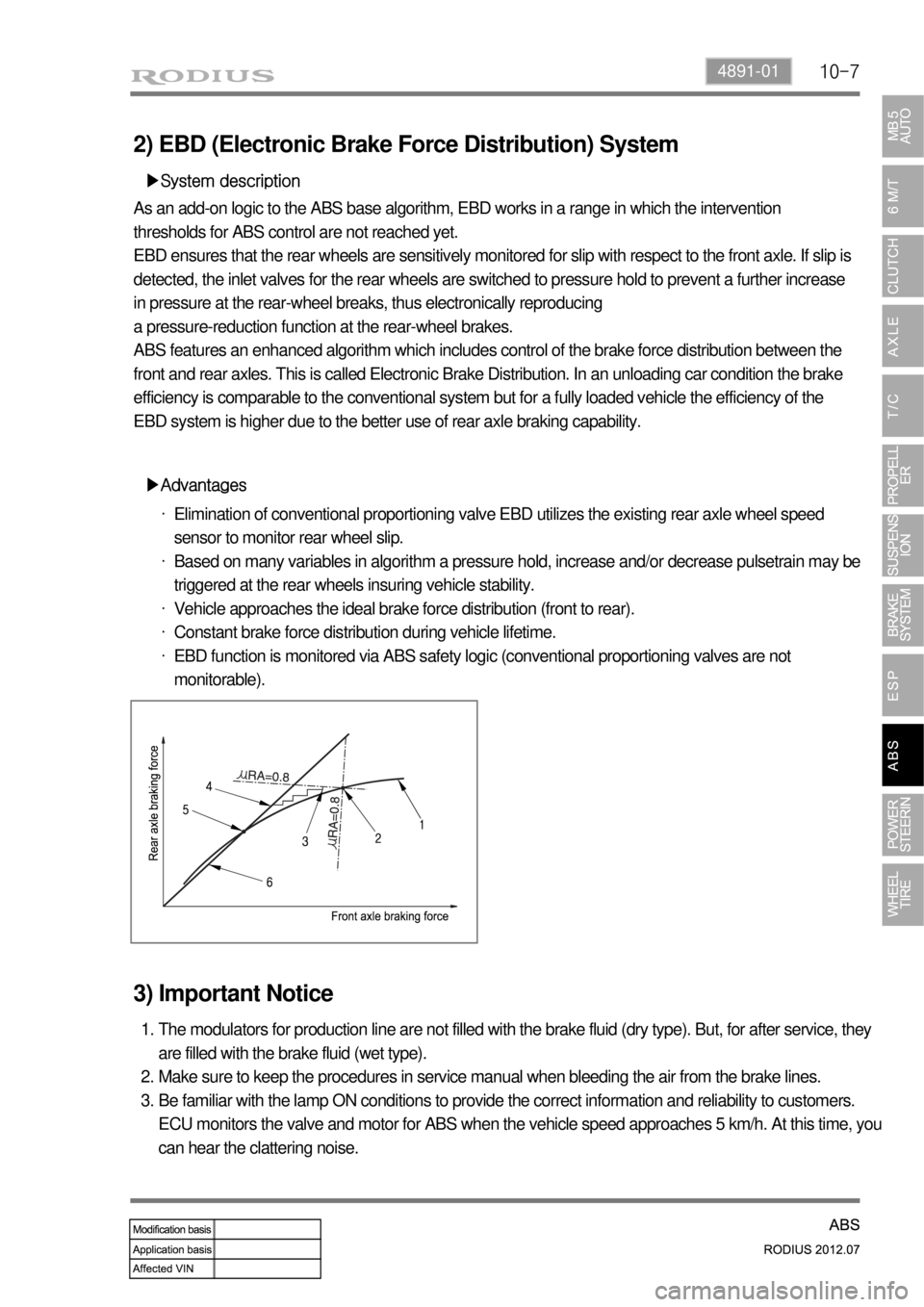Page 148 of 715
01-6
3. ENGINE COMPARTMENT LAYOUT
Do not work on the engine compartment while the engine, radiator, exhaust manifold, muffler
or catalytic converter is hot. Always turn the engine off and allow it to cool before starting the
maintenance.
Regularly check the engine oil level and add Ssangyong genuine engine oil if necessary.
Clean the dipstick with clean cloth so that any foreign materials cannot get into the engine. -
-
-
Power steering fluid
reservoir Brake fluid reservoir
Engine oil
dipstick gauge
Washer fluid
reservoir cap Engine oil filler cap
Air cleaner
Operating vehicle with insuffi cient amount of oil can damage the engine. Make sure the
engine oil level is correct and add oil if necessary.
Coolant reservoir
Battery
Fuse & relay
Page 522 of 715
01-33650-01
Diameter( Torque converter) 270mm
Lockup function Yes
Gear ratios 1st 3.595
2nd 2.186
3rd 1.405
4th 1.000
5th 0.831
Reverse:
S mode / W mode3.167/1.926
Driving type 2WD(4WD)
Fluid specification Shell ATF 134
Fluid capacityapprox. 8ℓ
Selected lever
indicationP.R.N.D Mechanical
D+/D- Electrical
Parking lock systemBrake switch(signal) → TGS lever
Reverse lock systemCAN → TGS lever
Selected lever
indicationP.R.N.D Lever position
1, 2, 3, 4, 5 CAN
Oil temperature
sensorResistance: R, D0.5 ~ 2.5kΩ
Resistance: P, N20kΩ
TCU EGS 52
Shift solenoid
valve(25℃)Resistance3.8 ± 0.2Ω
Operating distance 0.2mm
Operating current 1.5 ~ 2A
Item W5A580(2WD) / W5A400(4WD)
Input torque 450Nm
1. SPECIFICATIONS
Page 622 of 715
09-14
(2) Operation
The brake pressure value and the changed value of the pressure sensor are the conditions in
which the HBA System operates. There are 2 pressure sensors under the master cylinder. When
the ESP ECU system determines that emergency braking is present, the pump operates, the
brake fluid in the master cylinder is sent to the pump and the braking pressure is delivered to the
wheels via the inlet valves.
If the drive depress the brake pedal slowly, the pressure change is not high. In this case, only the
conventional brake system with booster is activated.
Page 626 of 715
09-18
(3) Hydraulic Circuit Diagrams in Conditions
▶Idling and Normal Braking Condition
In this position, the separation valve and the inlet valve are open (normal open), the electrically
operated shuttle valve and the outlet valve are closed.
When the brake is applied under these conditions, the brake fluid will be sent to each wheel via
the separation valve and inlet valve.
Page 636 of 715

10-74891-01
2) EBD (Electronic Brake Force Distribution) System
▶System description
As an add-on logic to the ABS base algorithm, EBD works in a range in which the intervention
thresholds for ABS control are not reached yet.
EBD ensures that the rear wheels are sensitively monitored for slip with respect to the front axle. If slip is
detected, the inlet valves for the rear wheels are switched to pressure hold to prevent a further increase
in pressure at the rear-wheel breaks, thus electronically reproducing
a pressure-reduction function at the rear-wheel brakes.
ABS features an enhanced algorithm which includes control of the brake force distribution between the
front and rear axles. This is called Electronic Brake Distribution. In an unloading car condition the brake
efficiency is comparable to the conventional system but for a fully loaded vehicle the efficiency of the
EBD system is higher due to the better use of rear axle braking capability.
▶Advantages
Elimination of conventional proportioning valve EBD utilizes the existing rear axle wheel speed
sensor to monitor rear wheel slip.
Based on many variables in algorithm a pressure hold, increase and/or decrease pulsetrain may be
triggered at the rear wheels insuring vehicle stability.
Vehicle approaches the ideal brake force distribution (front to rear).
Constant brake force distribution during vehicle lifetime.
EBD function is monitored via ABS safety logic (conventional proportioning valves are not
monitorable). ·
·
·
·
·
3) Important Notice
The modulators for production line are not filled with the brake fluid (dry type). But, for after service, they
are filled with the brake fluid (wet type).
Make sure to keep the procedures in service manual when bleeding the air from the brake lines.
Be familiar with the lamp ON conditions to provide the correct information and reliability to customers.
ECU monitors the valve and motor for ABS when the vehicle speed approaches 5 km/h. At this time, you
can hear the clattering noise. 1.
2.
3.
Page 643 of 715

11-54610-00
3. TROUBLESHOOTING
Problem Possible Cause Action
Movements of steering
feels heavyUnregular wear or binding of steering ball joint
due to lack of lubrication or foreign material
insertionLubricate or replace
Damaged or defective steering gear Replace the steering gear
assembly
Incorrect steering pinion preload Adjust
Defective steering shaft join Replace
leakage of steering fluid Repair or replace
Insuffcient steering fluid or air insertionFill up fluid or bleed air
Defective steering oil pump Replace
Damaged or loosened pump drive belt
Adjust or replace
Clogging of fluid line Repair or replace
Damaged wheel or tire Repair or replace
Defective suspension Repair or replace
Steering wheel pulls to
one sideDamaged steering linkage Replace
Damaged wheel or tire Repair or replace
Defective brake system Repair or replace
Defective suspension Repair or replace
Excessive free play of
steering wheelWorn steering gear Replace the steering gear
assembly
Worn or damaged steering ball joint Replace
Looseness of steering gear box Retighten
Poor returning of steering
wheelBroken or binding of steering ball joint Replace
Improper correct steering pinion preload Replace the steering gear
assembly
Damaged wheel or tire Repair or replace
Defective suspension Repair or replace